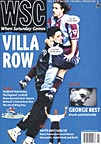 MLS has abandoned the Americanisms in soccer to please supporters familiar with the game as it is played across the rest of the globe. Mike Woitalla reports
MLS has abandoned the Americanisms in soccer to please supporters familiar with the game as it is played across the rest of the globe. Mike Woitalla reports
When Major League Soccer kicked off for its fifth season last month, there were a number of new rules for the fans to get used to. For once, however, they were intended to drag the US back towards the mainstream of world football. Arguments over the rules in the MLS date back to a meeting in New York some years ago. Those present plotted the return of a professional league in 1996. And they believed in enlarging the goals.
One objected. This purist, DC United’s Kevin Payne, argued that foreign players would resist Major League Soccer if it differed radically from the international game. The others, claiming soccer’s low-scoring stifles its popularity in the US, fought on. Finally, Payne pulled the ace from his sleeve. He told his colleagues that if they could tell him the current size of the goals, he would acquiesce to their request to enlarge.
They were stumped, and MLS kicked off with normal posts and crossbars. But the league did introduce two abnormalities. The first was minor: playing time would be kept on the scoreboard and the clock would run backwards, as in other American sports. The second was the shoot-out, resurrected from the North American Soccer League, which gave each shooter five seconds to score after embarking on a run from the 35-yard line (itself a novel pitch marking). Unlike penalties, relied on elsewhere only as a last resort, the shoot-out was used all season long.
Why do you need tiebreakers for league games? This question came up 18 years ago, when I took a sociology of sport class at UC Berkeley from Harry Edwards, the man best known as the organiser of the fist-in-the-air protests at the 1968 Olympics. Edwards noted that every major American sport used a tiebreaker in every game. “America is a country of winners and losers!” he bellowed. “We do not accept an in-between.”
That Americans will not accept aspects of sports that are common abroad often dictates soccer decisions here. Some are minor, but irritating. MLS won’t list the home team first in schedules and when results are given out, the winners are always listed first. Nor do we use aggregate scores in knock-out phases – playing best-of-three series instead – because soccer leaders don’t think Americans will understand the idea of adding up scores, let alone the away goals rule.
But the shoot-out backfired. Fans hated it. Players embarrassed themselves with frequent misses – one infamous battle of futility went on for 16 rounds. The Hispanic press mocked it. Coaches loathed it because they got no points if they lost a shoot-out and just one if they won. All too often games would end 3-3 in regulation time and the newspaper stories and TV highlights would focus on the post-game crapshoot.
Near the end of year four, the new MLS commissioner Dan Garber arrived to find a league whose average attendance had sunk to 14,000 and whose investors had lost more $100 million. He responded by giving the clock back to the refs and dumping the shoot-out. Now we have ten minutes of golden goal extra time, but a draw stands if no one scores.
“Millions of fans in America follow soccer the way it is played across the globe,” he said. “Our core audience spoke, and we listened.”
So the shoot-out turned out to be a good thing after all. It made soccer leaders realise they were repeating the mistake of generations of US soccer promoters before them. By catering to potential fans, who they hoped to entice with gimmicks, they ignored the real fans. The ones who would support a league if it gave them the genuine game.
From WSC 159 May 2000. What was happening this month